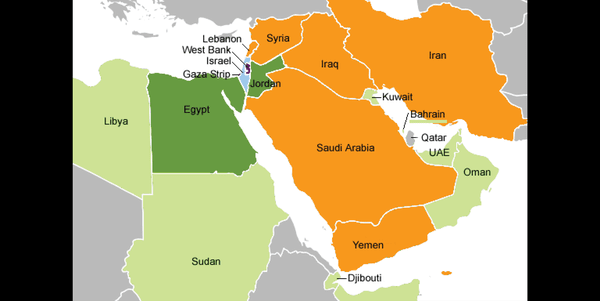The United States Wins Big by Investing in Israel
January 15, 2016

The annual U.S. investment in Israel — erroneously defined as “foreign aid” — has yielded one of the highest rates of return on U.S. investments overseas. Israel is no longer a supplicant and it has transformed itself from a national security and economic consumer to a national security and economic producer, generating substantial dividends that exceed the annual investment by its lead investor, the U.S.
U.S. national and homeland security and commercial interests have derived significant benefits from the special U.S.-Israel cooperative alliance, which has evolved into a unique, mutually beneficial relationship, transcending the tension between President Barack Obama and Prime Minister Benjamin Netanyahu and rising above the 68-year-old U.S.-Israel disagreements over the Arab-Israeli conflict and the Palestinian issue.
A case in point is the intensified cooperation between the air forces of both countries, as institutionalized by an unprecedented June 2015 strategic agreement, which established 12 teams of officers, codifying a widening range of joint annual agenda: operations, battle tactics, training, maintenance, repairs, airborne medicine, flight safety, and more, in the face of mutual threats, joint interests and constrained budgets.
For example, this year, U.S. combat pilots benefit uniquely during joint drills with their Israeli colleagues. The Israelis always fly in a “do-or-die” state of mind — a result of Israel’s narrow geographic waistline in a violently unpredictable neighborhood — which generates more daring and innovative maneuvers, shared with their U.S. colleagues. Recently, Israel’s air force developed a groundbreaking method of identifying, repairing and pre-empting cracks in old combat planes, such as the F-16, and this was promptly shared with the U.S. Air Force and aircraft manufacturers. Instead of grounding the planes for six months and preoccupying hundreds of mechanics, the Israeli-developed system — based on a baby-viewing ultrasound device — requires two weeks and only a few mechanics, yielding significant economic and national security benefits.
In 1966, 1969 and 1989, Israel snatched a Soviet Mig-21, a most advanced P-12 Soviet early warning radar and ELINT (electronic signals intelligence) system and a Soviet MiG-23 from Iraq, Egypt and Syria respectively. All were transferred to the U.S., which evaluated the technologies and integrated the lessons into the U.S. battle tactics, counter-measures and defense industries, tilting the global balance of power in favor of the U.S. and provided providing the U.S. defense industries with a substantial competitive edge. In 1982, Israel devised innovative technologies and battle tactics, setting groundbreaking standards for orchestrated air operations and proving — for the first time ever — that the most advanced mobile Soviet SAMs (surface-to-air missile) could be jammed, penetrated and destroyed. Twenty SAM batteries, deployed by Syria, were dismembered, and 89 Soviet MiG-21s, MiG-23s and Su-20s were downed in the process. The Israeli lessons were shared with the U.S., dramatically enhancing U.S. military, technological and industrial capabilities, causing another setback to the Soviets.
The 1967 and 1973 wars highlighted Israel as a critical outpost, advancing U.S. interests regionally and globally, crushing the military forces of anti-U.S., pro-Soviet Arab regimes (Egypt and Syria) and snatching pro-U.S. Arab regimes (Saudi Arabia and the Gulf States) from the jaws of defeat. In addition, the Israel Defense Forces served as a laboratory testing the performance of U.S.-made weaponry against Soviet-made weaponry. Thus, in 1974, some 50 U.S. military experts, headed by Gen. Donn Starry, spent six months studying Israel’s battle tactics and the captured Soviet military systems, producing eight thick volumes, which enhanced the U.S. defense of Europe during the Cold War and U.S. air and land battle doctrines during the 1991 Gulf War.
Gen. (ret.) Chuck Krulak, former commandant of the U.S. Marine Corps, conducted his 1991 battles against Saddam Hussein’s Russian tanks in accordance with the 1973 Israeli tank battles against Soviet tanks in Sinai. In 2014, Krulak said: “The U.S. battle tactic formulation, at Fort Leavenworth, Kansas, the intellectual Mecca of the U.S. Army, is based on the Israeli book.”
According to Gen. George Keegan, a former U.S. Air Force Intelligence chief, the value of intelligence shared by Israel with the U.S. — exposing adversaries’ air force capabilities, new military systems, electronics and jamming devices — “could not be procured with five CIAs. … The ability of the U.S. Air Force in particular, and the Army in general, to defend whatever position it has in NATO, owes more to the Israeli intelligence input than it does to any other single source of intelligence, be it satellite reconnaissance, be it technology intercept, or what have you.”
A similar assessment was made by the late Sen. Daniel Inouye, former chairman of the Intelligence Committee, the Appropriations Committee and its Defense Subcommittee. “Israel provides the U.S. with more intelligence than all NATO countries combined, especially on adversarial Muslim countries and terrorists targeting Americans abroad and on the mainland,” he said.
The Israeli Air Force, which flies U.S.-made aircraft, is the most cost-effective, battle-tested laboratory of the U.S. Air Force and defense industries. It shares with them, online and in real time, operational, maintenance and repair lessons, which enhance U.S. battle performance and upgrade research and development, global competitiveness, exports and the employment base of the U.S. defense industries (such as Lockheed-Martin, McDonnell Douglas, Bell Helicopter, Boeing Defense, Northrop Grumman, and so on). Similar lessons, experienced by the Israeli military, have been shared with the U.S. Army, Navy and Marine Corps and all related industries, valued at many billions of dollars, yielding game-changing contributions to U.S. national and homeland security.
In 2016, against the backdrop of mounting conventional and terrorist threats, the collapse of Europe’s military power projection, the erosion of the Western posture of deterrence, and the growing instability, fragmentation, unpredictability and doubtful reliability of pro-U.S. Arab regimes, Israel stands out as the most stable, predictable, reliable, capable and productive (militarily and commercially), democratic, unconditional ally and beachhead in a critical region, extending the strategic arm of the U.S. military, which has been burdened by draconian cuts.
By: Yoram Ettinger
Similar posts
-

Israel Is Held To A Higher Standard Than Any Country
April 25, 2024In the intricate tapestry of global affairs, one nation stands out for enduring scrutiny and condem...
-

Israel Has The Most Moral Military In The World
April 10, 2024In the heart of a region often riddled with conflict, Israel stands out not only for its technologi...
-

The Resilience of the Israeli People
April 2, 2024Visitors from around the world have seen Hamas's October 7th Massacre's destruction in southern Isr...
-

Israel: Small Size, Big Impact
March 21, 2024Nestled along the eastern edge of the Mediterranean Sea, Israel is a land of immense historical sig...
-

Israelis Are Fighting For Their Lives
February 21, 2024By Jonathan S. Tobin The world looks a lot different from Kibbutz Kfar Aza than it does in the U...
-

Over 2 Million Arabs Live In Israel
January 23, 2024In the complex landscape of the Middle East, where diverse cultures and identities intersect, Israe...
-

'Fauda' Star Idan Amedi Injured Fighting in Gaza
January 8, 2024Despite the severity of his injuries, Amedi's father assured Israeli news channels that his life is...
-

Israel Is A Great Country To Live In
December 28, 2023Nestled at the crossroads of the Middle East, Israel stands as a vibrant and dynamic nation, offeri...



















